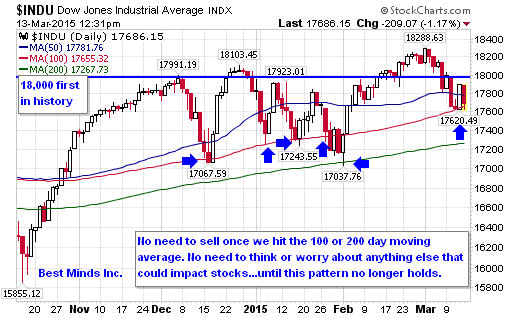Free Money; What Could Go Wrong?
Stock-Markets / Financial Markets 2015 Mar 14, 2015 - 04:11 PM GMTBy: Doug_Wakefield
 Isn’t all of this QE (quick and easy) money great? When the Federal Reserve shut down their latest Quantitative Easing program last October (the largest “free money” scheme in American history), the Bank of Japan was ready to expand their largest “free money” scheme, and starting on March 9th this week, after many attempts to kick start its own “free money” scheme in Europe, the European Central Bank kicked off its own Quantitative Easing program.
Isn’t all of this QE (quick and easy) money great? When the Federal Reserve shut down their latest Quantitative Easing program last October (the largest “free money” scheme in American history), the Bank of Japan was ready to expand their largest “free money” scheme, and starting on March 9th this week, after many attempts to kick start its own “free money” scheme in Europe, the European Central Bank kicked off its own Quantitative Easing program.
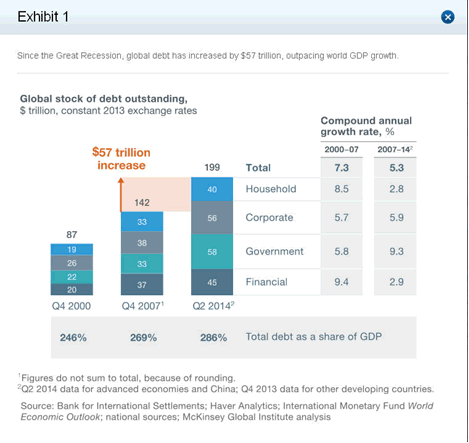
[Source – Debt and (not much) deleveraging, McKinsey Global Institute, Feb ‘15]
However, I keep reminding myself of a principal I was taught early in life, “Nothing is free.”
The chart at the open is from a recent report by McKinsey Global Institute. Two things stand out to me from this chart. The first is the $57 trillion increase in outstanding debt since the fourth quarter of 2007. Merriam Webster’s online dictionary defines debt as follows:
“the state of owing money to someone or something” and
“the fact that you have been influenced or helped by someone or something”
The second observation from the chart was the reversal in roles between households and governments. Notice how in the 2007-2014 period, households reduced the speed of taking on debt, whereas governments increased theirs.
Now help me out. If you owe someone money, how can it be “free”? If you have been influenced or helped by someone that you will later “owe money” from a debt, would you not set out with a plan for how you would pay off that debt?
If you are an individual, the answer is usually yes. If you are a global corporation, maybe, unless buying back your own stock could help create the illusion of strength and the cost of the debt was pushed out into the future, possibly after you have left the company. If you are a national or international governing agency, then it would be very tempting to “influence someone” with the power to hand out that “free money”, even seeing that as part of your responsibility.
However, in our world today, the only institution that can kick start the creation of “free money” or the idea of “unlimited debt is leading us to a recovery” are the world’s central banks, and primarily, the central banks representing the largest currencies in circulation in the world.
So at the end of the day, the chart from McKinsey showing a $57 trillion debt load increase in 7 years – remember, that is more than three times the entire U.S. national debt load as we start 2015 ($18 TR) – is a consequence of all the “debt without future consequences” schemes that have taken place since the Great Recession.
Default, Restructure, Increase Taxes and Reduce Spending, or Hyper-inflate
At this stage, in looking around the world, whether president of an international financial institution or main street investor, we have all become dependent on global bankers and global politicians to keep the illusion of “free money will eventually bring recovery”, or put another way, “the faster we create debt loads worldwide, the faster things can return to ‘normal’”.
Global bankers and economists know there are only 4 solutions to the obsession of creating an illusion, rather than the determination of dealing with reality.
The point of this short article is not to discuss how things could be corrected, because it has become painfully obvious that the majority view is that we don’t need to fix it, we just need to keep up the illusion as long as possible. However, defaulting on debt, restructuring debt, increasing taxes and reducing spending, and hyperinflating one’s currency, have all been used in the last century. None are widely embraced. All produce a great deal of pain across a society.
But one thing is clear from the McKinsey report and many others showing the growth of global debt; the largest contributor to this debt has been the “quick and easy” money that has been created since 2008, and the additional debt created by using this newly created debt as collateral.
What Can I Do?
- We must stop accepting experience as a confirmation of where our futures are headed. There is literally no way that we can cut interest rates any lower in order to continue the “recovery” myth. This is not a short-term issue, but a structural one that will impact everything worldwide for years to come. Any strategy based on “never sell no matter how high” is complete madness. Someone is ALWAYS selling as well and buying. Markets have proved this over centuries.
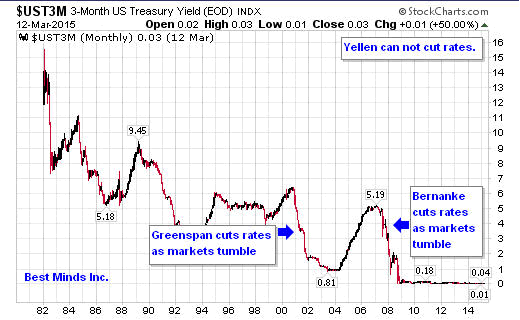
- Don’t say, “This has never happened here, and thus is can not”. This is where every American needs to understand what has taken place in Japan since 1990.
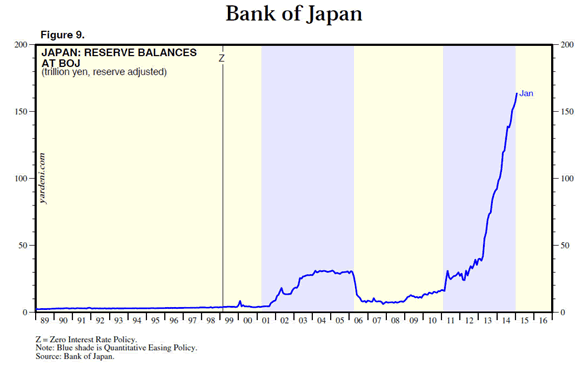
[Source – Global Economic Briefings: Central Bank Balance Sheets, Yardeni Research Inc, Dr. Edward Yardeni and Mali Quintana, Feb 20 ‘15]
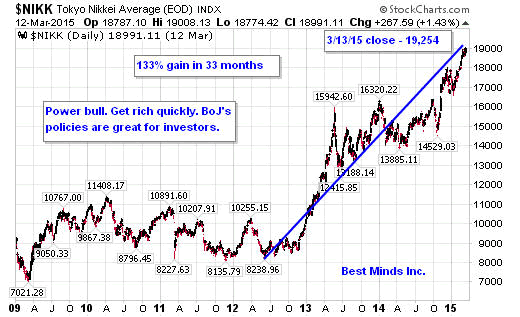
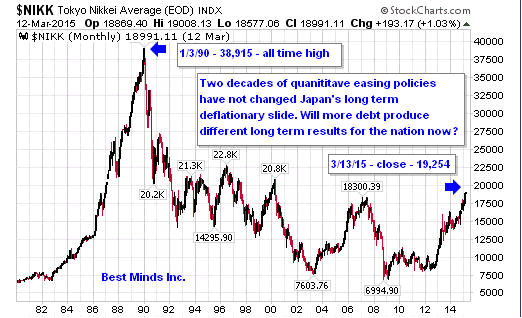
Make certain you understand that without intervention and speed of light computer programs leading the crowd, there is absolutely no way this many patterns would keep repeating themselves. The problem is, with more and more intervention, we are being warned that we have become DEPENDENT on central banks as massive buyers in world markets, or stated another way, we have come to embrace constant intervention by the state (i.e. central banks) as a good for our “free markets”.
Also, since computers are driven by math, not fear and greed, the extremes in the upside are just as prone to the downside. The upside provides an illusion of “a crowd”, thus produces more complacency among traders and investors. The downside hammers them with the reality that “the crowd” has left them “swimming naked when the tide goes out”.
Being a Contrarian
I have found that using the “nirvana trade”, one has been able to profit from being a contrarian as volatility has picked up greatly since mid 2014. Yet as traders say, “When everyone discovers a ‘sure thing’, the pattern loses its value”. Once the “nirvana line” no longer holds, the entire game and mood will change, especially since “stability” was built on trillions of additional debt.
Markets that have been moving lower since the fall of 2011 will change with those who have been on a rocket ride to the moon. The shorts will be forced to go long in certain markets and the longs will be forced to go short in others.
The Investor’s Mind was started in 2006, believing that asking questions was a good thing. 2015 seems set to prove why this is valuable, like 2008.
The risk from procrastination continues to rise. The value for good research is extremely low in comparison to the speed in which wealth can be destroyed. Click here to start the next six months reading the newsletters and trading reports as we come through this incredible year.
On a Personal Note
I have recently started a blog called, Living2024. It is a personal blog, not business. I wanted to have a place to write some deeper stories about where this entire drama seems to be taking us all. I hope you will check it out.
Doug Wakefield
President
Best Minds Inc., a Registered Investment Advisor
2548 Lillian Miller Parkway
Suite 110
Denton, Texas 76210
www.bestmindsinc.com
doug@bestmindsinc.com
Phone - (940) 591 - 3000
Alt - (800) 488 - 2084
Fax - (940) 591 –3006
Copyright © 2005-2011 Best Minds Inc.
Best Minds, Inc is a registered investment advisor that looks to the best minds in the world of finance and economics to seek a direction for our clients. To be a true advocate to our clients, we have found it necessary to go well beyond the norms in financial planning today. We are avid readers. In our study of the markets, we research general history, financial and economic history, fundamental and technical analysis, and mass and individual psychology.
Disclaimer: Nothing in this communiqué should be construed as advice to buy, sell, hold, or sell short. The safest action is to constantly increase one's knowledge of the money game. To accept the conventional wisdom about the world of money, without a thorough examination of how that "wisdom" has stood over time, is to take unnecessary risk. Best Minds, Inc. seeks advice from a wide variety of individuals, and at any time may or may not agree with those individual's advice. Challenging one's thinking is the only way to come to firm conclusions.
Doug Wakefield Archive |
© 2005-2022 http://www.MarketOracle.co.uk - The Market Oracle is a FREE Daily Financial Markets Analysis & Forecasting online publication.




